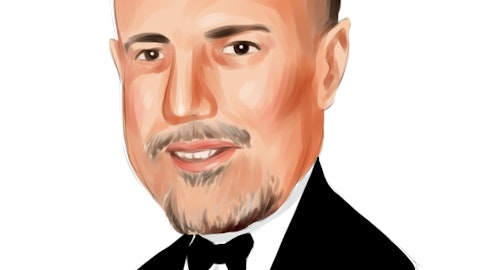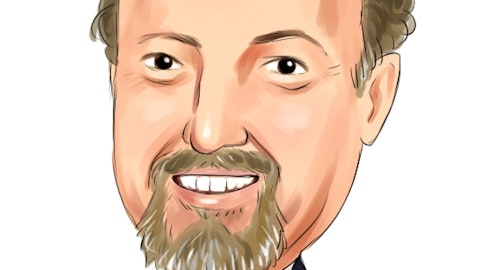John Healy: And I thought I had to ask this question because it’s come up a few times in your prepared remarks, the ROA comment. Is there a way to think about an ROA level that you view as acceptable or that you’ve kind of tasked the team with trying to achieve maybe in the near term and maybe over the long term?
Stephen Scherr: Well, I think — I mean, listen, you want to be — the way I would say it is, it’s all relative to sort of the competing uses of cash in the business, okay? So we’re going to look for a return on the invested dollar in fleet as measured against what we see in terms of the return profile of nonfleet CapEx to the business and equally what we see in the context of share repurchase. They’re all valid uses of capital and we need to make relative judgments, not absolute judgments in terms of where we deploy do. And if the return on the fleet is going to pay handsomely relative to other uses, we’ll put it there. If there is long-term value to the return profile of a Dollar into nonfleet CapEx, obviously, we’re going to look at that.
So capital allocation is going to be subject to great rigor, and I’d hate to put a particular number down and say we need it or not. It’s all a relative judgment. And obviously, long term, our desire is to keep a very high sort of pull through to free cash flow right, from the EBITDA number. And on a steady-state basis, I’d like that number to continue to be 70% or thereabout in terms of just the efficiency and the pull-through of EBITDA in through free cash flow. That doesn’t mean it’s going to happen every quarter or it happen every year, but I think you should view that as the target that we want to operate to and the relative sort of outlay and allocation of free cash flow will be subject to the rigors of return.
Kenny Cheung: Yes. And just to build on that one. In a steady state, John, right, if you just think the free cash flow build, right, you have EBITDA to operating cash flow, that’s 90%, which proved to be correct this year. And then you also have in a steady state, you would have the fleet size, cap costs, et cetera, would be somewhat steady. So nonfleet growth will be minimal in that equation. So — and then, call it, not CapEx, call it, close to historical levels. Is that how you walk to the 70% of conversion from EBITDA.
Operator: Our next question comes from the line of Adam Jonas with Morgan Stanley.
Adam Jonas: Well, for Steve and Kenny, thanks for all the details, and it really does help us model and helps manage expectations, so well done for that. But the one thing you left out is on fleet interest expense outlook, $159 million last year, it’s down about 45% year-on-year and well down $400 million from a few years ago pre-COVID. Now I know things have changed. But as your hedges roll and you see a step-up in funding costs from the ABS market, what should we be thinking about on fleet interest costs for 2023? And then I have a follow-up.
Stephen Scherr: Sure. So I’ll have Kenny give you sort of some precision around the numbers, but the hedges that we have in there, Adam, are going to roll on the forward. We’re obviously watching and managing them. These are not new to me just given what I did before. And so they’ve proven to be very valuable to us in locking in sort of the cost function of the interest expense. Kenny, maybe you want to speak to sort of the numbers themselves.
Kenny Cheung: Yes. So if you think about our structure on the debt stack, right? So roughly 75% of our costs are fixed base, right? And then most of majority — the majority of our costs are on the ABS side. And roughly 80% of that is fixed as well. Last year, our blended cost was roughly 2.5% is very effective from a cost borrowing standpoint. Entering this year, we expect this number to be roughly around 3% to 3.5%, Adam, for — on the EPS side. As Stephen mentioned, we have hedges in place. So for example, roughly 40% of the ABS is variable funding notes we are contractually to have caps in place on those. And right now, they’re currently in the money as we speak. And we sell this going through the P&L in Q4.
Adam Jonas: Just to clarify that before my follow-up, you’re saying 3% to 3.5% of the ABS side, but with hedges in place, that are in the money, you might have up better than that. We should be thinking that, that could be even better than that in terms on fleet interest?
Kenny Cheung: Yes. 3% to 3.5% with caps. Yes, 3% to 3.5% gross.
Adam Jonas: And just, Steve, your point on using conservative and prudent assumptions. I think you made that point many times. I didn’t know if there was any way you could tell us what your assumptions are on Manheim throughout the year or a range of that? Presumably, it’s further declined, but I didn’t know what we should be thinking of in there because you’re still allowing for $50 per unit of gain on sale. I don’t recall how normal that is to have that order of magnitude gain on sale. But any color there without holding it to a specific index our — of course, of course.
Stephen Scherr: Sure. Yes, of course, of course. I would say the following. As you would expect, we model, particularly around the ABS facility on a very conservative basis because I don’t want a surprise. And so I want to understand what the risk is to us having to put equity into the ABS facility under a variety of sort of scenarios. And so we model to an annual decline in residual pricing that’s probably a couple of hundred basis points wide of what the indices sort of publicly report, okay? Now those vary, and they depend on which segment of the fleet population you look at but I think we model on a conservative basis. And then I look at kind of standard deviation movement to price to sort of understand what’s our risk level and tolerance against those very conservative assumptions we believe that there’s no scenario as we look forward, whereby we’re going to be required to sort of put money into the ABS.
Now anything can change, but I think we take a fairly conservative set of assumptions. Now carry that assumption about residual price decline in ’23. And I would say that we are on the conservative side, again, carrying that over from the ABS analysis into what we think gain on sale will be. And so I think that we look at what’s playing out over the last five weeks. We look at what we’re harvesting in terms of the increasing utilization of Carvana and our own proprietary channel, where we capture 5% to 7% premium to what we get in the wholesale market, take all of that together, and I’m still quite optimistic about the ability to harvest fairly have some gain on sale. It won’t be what it was at the top of 2022, but there’s enough in there, right, to offset gross depreciation.
So that’s a little bit of the narrative, Adam, in terms of how we think about residual decline relative to the market, primarily for ABS, but then carrying it over to sort of sort out what we think expected gain on sale will be, again, both through wholesale and again, an increasing use of premium channels.
Operator: Our next question comes from the line of Ryan Brinkman with JPMorgan.





